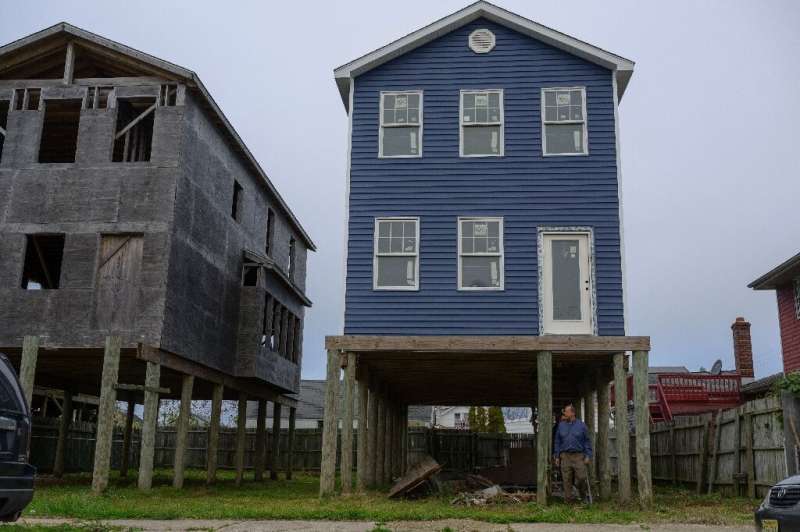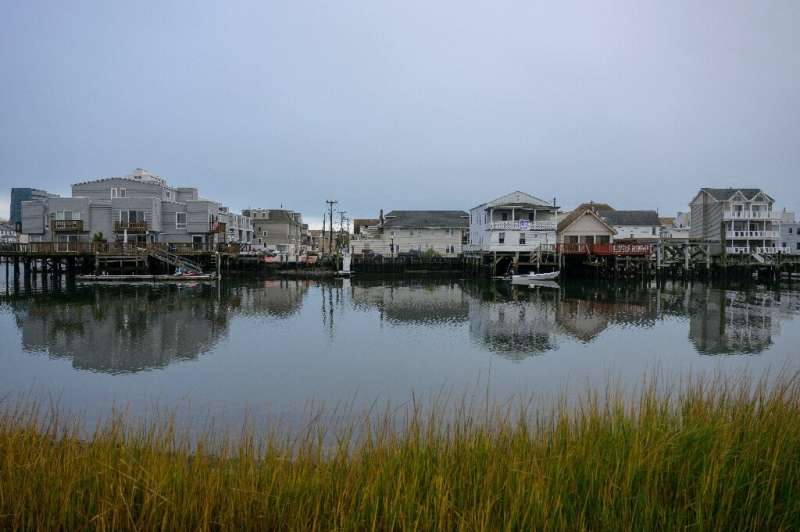Atlantic City, where flooding is still an almost daily part of life a decade after Sandy.
A decade after Superstorm Sandy devastated the US East Coast, the coastal city of Atlantic City has strengthened its famous boardwalk that narrowly separates casinos and the ocean.
But in some neighborhoods, flooded streets have become routine.
North of the city, dubbed the Vegas of the East Coast, a new stretch of boardwalk is protected from crashing waves by a rock barrier and seawall, a $60 million project completed in 2018.
Further inland stands something of a wasteland where a few buildings still stand, surviving the ravages of the deadly storm.
Jim Rutala, a private planning consultant for the city, said the tens of millions invested in the shoreline had “provided tremendous protection” and could accommodate new construction.
Founded in the 19th century as a spa resort, Atlantic City celebrated its golden age during the Prohibition era of the 1920s, a haven for revelers and the high-profile crowd before later becoming a tourist destination thanks to of its nightclubs and casinos.
“Economic Generator”
The city immortalized in Bruce Springsteen’s song has always benefited from its location on the seafront, but the threat of rising waters makes the area increasingly vulnerable.
On October 29, 2012, Sandy, which left more than 100 people dead in the United States, caused severe damage to nine percent of homes in Atlantic City, according to the state of New Jersey.

A sign marking the height of water when Sandy hit Atlantic City in 2012, seen at Vagabond Kitchen and Tap House.
The city of about 40,000 people is a “huge economic generator,” Rutala said, where 35 percent of residents live in poverty.
Further south, where hotels, casinos and restaurants fill the seafront, some of the coastline was able to withstand Sandy thanks to beaches and artificial dunes that the Army Corps of Engineers had built with millions of cubic yards of sand washed out to sea.
Without them, “the water would be lapping up the boardwalk,” said Kimberly McKenna, associate director of Stockton University’s Coastal Research Center.
But “at some point we’re either going to run out of sand or it’s going to be too expensive to maintain,” the geologist said.
Flooding at high tide
Heading a little deeper into the back of the bay shows how quickly the water that made Atlantic City a tourist hot spot can become a hindrance.

Aerial view of the Chelsea Heights neighborhood in Atlantic City.
“Every time it rains, any rain other than light rain will cause flooding on this street,” said lifelong resident Thomas Guiteau.
The 62-year-old pensioner has worked in casinos for decades and has always lived on the same street with modest homes.
“We even have a joke that if it gets foggy, it will flood. And that’s true. Because every time we have a full moon or some kind of storm comes, the water comes out through the drain and the street will flood all the way to the porch and sometimes it even goes inside the house,” Guiteau told AFP.
Tidal flooding is likely to become more common as sea levels rise due to climate change.
Atlantic City should expect to experience such flooding between 17 and 75 days a year by 2030, compared to less than once a year in 1950, according to a 2019 study by Rutgers University.

Freddie Restrepo outside his Atlantic City home that was destroyed by Superstorm Sandy a decade ago.
In the Chelsea Heights neighborhood, Freddy Restrepo and his sister Paula, immigrants from Colombia, lost both of their back-to-back homes in Sandy.
After 10 years and a series of mishaps, they were only able to rebuild the walls and foundations, which are now raised, as are a number of properties in the area.
Today, according to Restrepo, the street often floods.

Streets frequently flood in the Chelsea Heights neighborhood of Atlantic City, shown here.
“much worse”
Nearby at his Vagabond Kitchen and Tap House, co-owner Elvis Kadavid says “things just got a lot worse.”
“We are aware of when the flood is going to happen,” he said. “So we’re dealing with that, we’re delaying opening, sometimes closing early. If it’s really bad, we might close for the day, we might lose a day.”
Rutala said the city, aware of its weak points, has begun to upgrade its drainage system and has built several barriers bordering the inner bay.

Streets frequently flood in the Chelsea Heights neighborhood of Atlantic City, shown here.
[PIC=1048718:left]
After Sandy, more than 300 Atlantic City homeowners — and more than 7,000 in New Jersey — received an average of more than $120,000 in rebuilding assistance, according to state data.
But Rutala said at least 200 homes were still classified as regular flood victims.
Amid rising seas, Atlantic City has no plans to back down
© 2022 AFP
Quote: Ten years after Sandy, Atlantic City still suffers from flooding (2022, October 29) Retrieved October 29, 2022, from
This document is subject to copyright. Except for any fair dealing for the purposes of private study or research, no part may be reproduced without written permission. The content is provided for informational purposes only.
https://phys.org/news/2022-10-ten-years-sandy-atlantic-city.html

